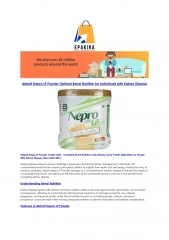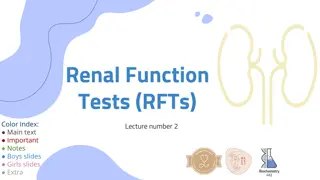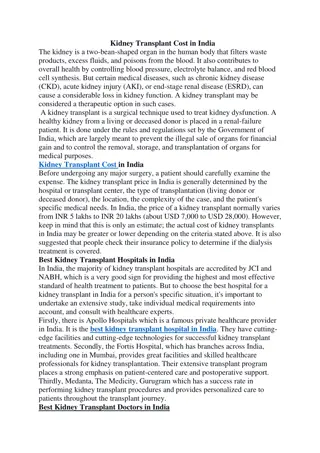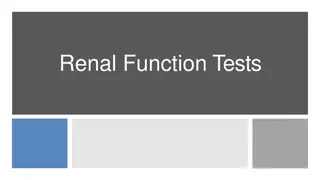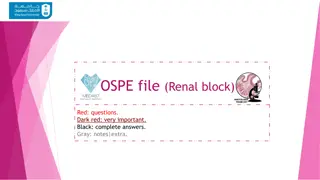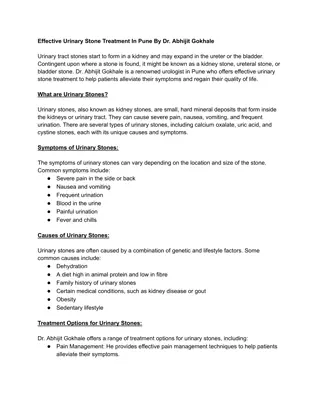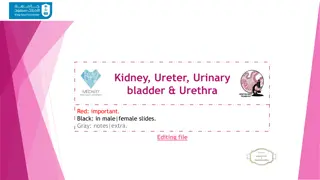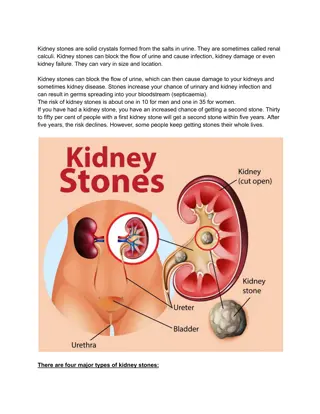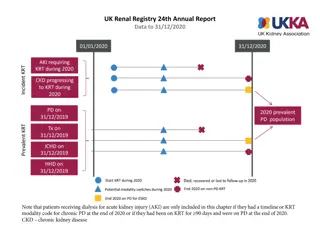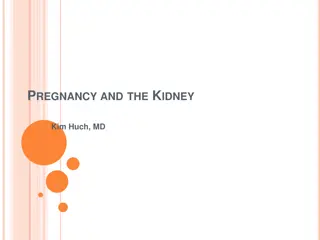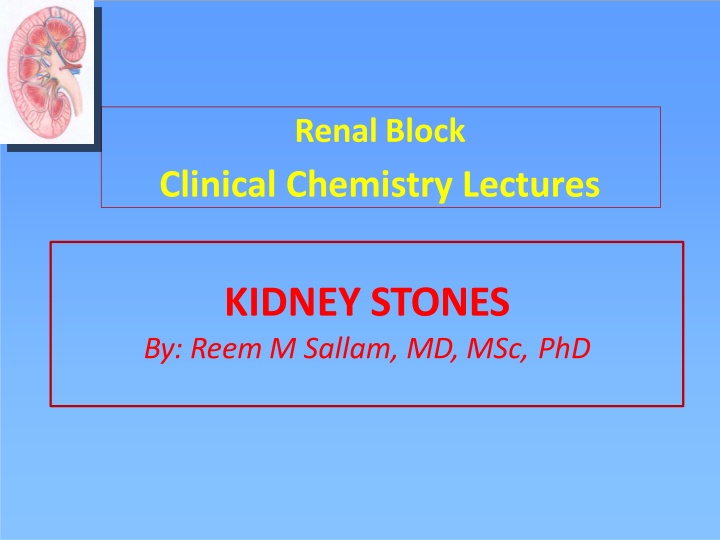
Factors Contributing to Kidney Stones Formation
Explore the physiological and pathological factors leading to kidney stone formation, including urinary concentrations, pH changes, urinary stagnation, and lack of inhibitors. Gain insights into the characteristics of kidney stones for proper identification, diagnosis, treatment, and prevention.
Download Presentation

Please find below an Image/Link to download the presentation.
The content on the website is provided AS IS for your information and personal use only. It may not be sold, licensed, or shared on other websites without obtaining consent from the author. If you encounter any issues during the download, it is possible that the publisher has removed the file from their server.
You are allowed to download the files provided on this website for personal or commercial use, subject to the condition that they are used lawfully. All files are the property of their respective owners.
The content on the website is provided AS IS for your information and personal use only. It may not be sold, licensed, or shared on other websites without obtaining consent from the author.
E N D
Presentation Transcript
RenalBlock Clinical Chemistry Lectures KIDNEY STONES By: Reem M Sallam, MD, MSc, PhD
OBJECTIVES Upon completion of this lecture, the students should be ableto: Recall general physiological and pathological factors that favor kidney stones formation. Identify the chemical constituents and characteristics of kidney stones that help in identifying the causes, diagnosis, treatment and prevention of kidney stones.
What are kidney stones ? Kidney stones (renal calculi) are stones that are formed in renal tubules & are usually composed of products of metabolism present in normal glomerular filtrate often at concentrations near their maximum solubility
Conditions favouring kidney stones formation 1. High urinary concentrations of constituents of glomerularfiltrate 2. Change in pH of urine 3. Urinarystagnation 4. Lack of normal inhibitors of stoneformation inurine
Conditions favouring kidney stones formation 1 High urinary concentrations of one ormore constituents of glomerular filtrate due to: - urinary volume (with normal renal function) Restricted fluidintake fluid loss over a long period of time - rate of excretion of metabolic products forming stones plasma volume (that increases filtratelevel) tubular reabsorption fromfiltrate
Conditions favouring kidney stones formation (cont.) 2 Change in pH of urine - often due to bacterial infection - precipitation of different salts at different pH: A persistently acidic urine promotes uric acid precipitation A persistently alkaline urine (due to upper urinary tract infection) promotes Mg Ammonium Phosphate crystals (Struvitestones) 2 Urinarystagnation: - Due to obstruction of urinary outflow
Conditions favouring kidney stones formation (cont.) 4 Lack of normal inhibitors in urine - Inhibitors of stone formation: e.g.: Citrates Pyrophosphate Glycoproteins - Inhibit the growth of Ca++ salts crystals - In type I renal tubular acidosis, hypocitraturia renalstones
Constituents of Kidney Stones 1- Stones of calcium salts 2- Uric Acid stones 3- Magnesium ammonium phosphate stones 4- Cystinestones 5- Others (xanthine, etc)
Stones of Calcium Salts e.g. Calcium Oxalate Stones
Constituents of Kidney Stones: 1-Stones of calciumsalts 80% of patients with nephrolithiasis form calciumstones: Mostly: Ca-Oxalate Less often: Ca-Phosphate Type of salt dependson: pH of urine & Availability of oxalate
Constituents of Kidney Stones: 1-Stones of calcium salts (cont.) Characters: white, hard & radio-opaque Ca-Oxalate: smaller, lodge in ureter Ca-Phosphate: staghorn, in renal pelvis (big)
Constituents of Kidney Stones: 1-Stones of calcium salts (cont.) Main causes favouring formation of calcium salts stones: 1 Hypercalciuria: Defined as daily urinary Ca excretion >6.2 mmol in & >7.5 mmol in due to hypercalcemia (most often due to 1aryhyperparathyroism) sometimes, Ca++ salts stones are found with nohypercalcemia 2 Hyperoxaluria (more important) - favours formation of calcium oxalates (even with no hypercalciuria) - causes: exogenous (diet rich in oxalate ) absorption (in fat malabsorption) 1ary hyperoxaluria: inborn errors , in childhood , urinary oxalates > 400 mol/24hours
Constituents of Kidney Stones: 1-Stones of calcium salts (cont.) Conservative lines oftreatment: Treatment of primary condition (i.e. Infection, hypercalcemia, hyperoxaluria) Reducing oxalates in diet (it is not recommended to reduce calcium indiet) Fluid intake (if no glomerularfailure). Acidification of urine (as ppt. is favoured by alkaline conditions)
Constituents of Kidney Stones: 2-Uric acid stones ~ 8% of renal stones contains uric acid may be associated with hyperuricemia (with or without clinical gout) Acidification of urine favours Uric acid precipitation Characteristics: small, friable &yellowish may form staghorn (ifbig) radiolucent (can t be seen be plainX-ray) visualized by ultrasonography or I.V.Pyelogram
Constituents of Kidney Stones: 2-Uric acid stones, (Cont.) Treatment: Treatment of cause of hyperuricemia purine-rich diet Alkalinzation of urine (e.g. by potassium citrate) fluid intake
Mg ammonium phosphate (struvite) stone
Constituents of Kidney Stones: 3- Magnesium ammonium phosphate stones ~ 10% of all renal stones With chronic urinary tract infection (by urease splitting oraganisms as Proteus species ammonia production fromurea) Alkaline urine pH (>7.0) Treatment: Aggressive prevention & treatment of the cause (urinary tract infection) Urineacidification Fluidintake It may require complete stone removal (percutaneous nephrolithotomy) Aggressive prevention & treatment of future urinary tract infection
Constituents of Kidney Stones: 4- cystine stones Rare occurs in cases of homozygous cystinuria (inborn error of amino acid metabolism) Soluble in alkaline urine (precipitates by acidic urine) Treatment: fluidintake Alkalinzation ofurine Penicillamine
Investigations of patients with renalcalculi 1 Stone is available (with urine or by surgical intervention) laboratory investigations for detection of stone chemical constituents: - to know thecause - for decision of lines for preventive treatment 2 Stone is notavailable Blood analysis: calcium, uric acid, [PTH] Urine analysis: volume, calcium & oxalate Urine pH: > 8 suggestive of urinary tract infection (Mg amm. phosph.) Screening of urine for cystine: qualitative (if +ve: 24 hours urine) Renal tract imaging: CT, ultrasonography & I.V.pyelogram
To summarize: Evaluation & subsequent treatment Retrieve stones and send foranalysis. Subsequent therapy depends on stone & biochemical abnormalities. ALL patients should increase fluid intake to > 2L/day Do a complete evaluation in certain patients (those with moderate-highrisk: Middle-aged, White, Males, with + ve FamilyHistory Patients with chronic diarrheal states and/or malabsorption, pathological fractures, osteoporosis, UTIs, or gout. Patients with certain types ofstones: e.g. stones composed of calcium phosphate (hard stone) or struvite (@ risk for staghorn calculi)

